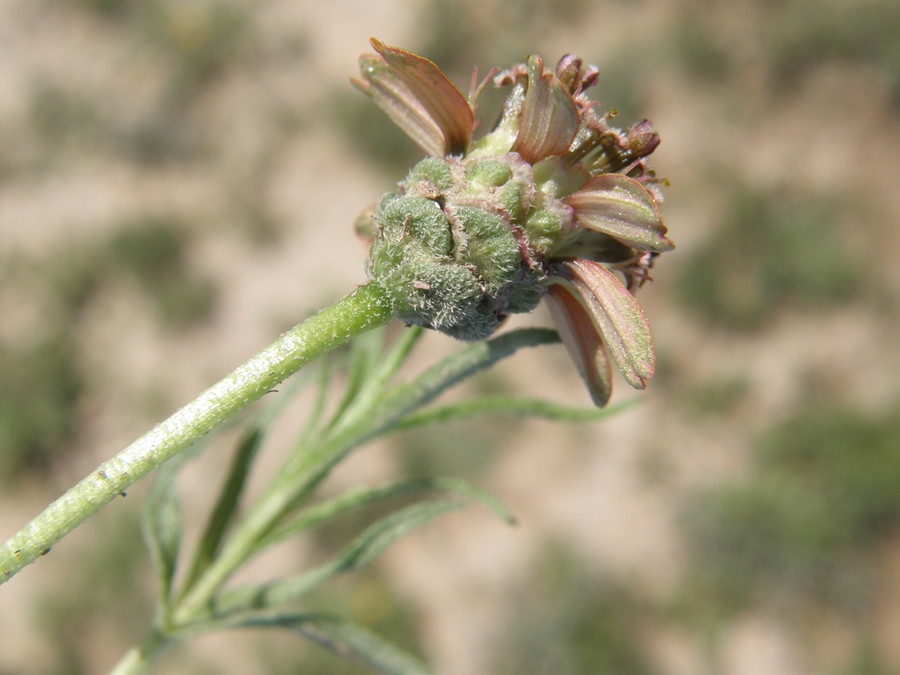Zinnia anomala
Common Name(s):
- Phonetic Spelling
- ZIN-ya ah-NOM-uh-luh
- Description
-
Shortray zinnia is a deciduous, herbaceous perennial or annual in the Asteraceae (Daisy) family. The plant is a native to western Texas and northern Mexico. It is considered a sub shrub, a low-growing woody perennial having a woody base. The genus, Zinnia, is named in honor of Johann Gottfried Zinn, a German botanist.
Growing only 8 inches tall. shortray zinnia needs full sun and soil that is occasionally dry or in very dry conditions. It can only be propagated by seed and should be planted less than 12 inches apart. This plant produces only one flower head per branch, each head containing about 7 to 20 gold or yellow rays. It blooms in the fall, spring, and summer months.
This variety of zinnia is not one that is readily available for purchase for your garden. However, if you are able to secure this plant, it is a hardy specimen, accustomed to flourishing in the most adverse conditions. It is also a photoautotroph, an organism that is capable of transforming light into chemical energy.
Shortray zinnia can be grown in containers, naturalized areas, or on slopes. This plant does well in mass plantings in drought tolerant, native, and rock gardens. It can be found growing along open, rocky roadsides and other disturbed sites.
Quick ID Hints:
- Mounding
- Multi-stemmed
- Green leaves with gold or yellow stems.
Insects, Diseases, and Other Plant Problems: No significant problems.
The Clemson Cooperative Extension Home and Garden Information Center has a factsheet on common zinnia insect pests and diseases.
VIDEO Created by Elisabeth Meyer for "Annuals, Perennials, Vines, and Groundcovers" a plant identification course offered in partnership with Longwood Gardens.
- Profile Video:
- See this plant in the following landscape:
- Cultivars / Varieties:
-
- Tags:








- Cultivars / Varieties:
-
- Tags:
-
-
Attributes:
- Genus:
- Zinnia
- Species:
- anomala
- Family:
- Asteraceae
- Life Cycle:
- Annual
- Perennial
- Recommended Propagation Strategy:
- Seed
- Country Or Region Of Origin:
- Texas, Mexico
- Distribution:
- TX
- Wildlife Value:
- Attracts pollinators
- Play Value:
- Attracts Pollinators
- Textural
-
-
Whole Plant Traits:
- Plant Type:
- Annual
- Herbaceous Perennial
- Woody Plant Leaf Characteristics:
- Deciduous
- Habit/Form:
- Mounding
- Rounded
- Maintenance:
- Low
-
-
Cultural Conditions:
- Light:
- Full sun (6 or more hours of direct sunlight a day)
- Soil Texture:
- Sand
- Soil Drainage:
- Occasionally Dry
- Very Dry
- Available Space To Plant:
- Less than 12 inches
- NC Region:
- Coastal
- USDA Plant Hardiness Zone:
- 8b, 9a, 9b
-
-
Fruit:
- Fruit Type:
- Achene
-
-
Flowers:
- Flower Color:
- Gold/Yellow
- Orange
- Flower Inflorescence:
- Head
- Flower Bloom Time:
- Fall
- Spring
- Summer
- Flower Shape:
- Radial
- Flower Petals:
- 7 - 20 petals/rays
-
-
Leaves:
- Woody Plant Leaf Characteristics:
- Deciduous
- Leaf Color:
- Gray/Silver
- Green
- Leaf Shape:
- Linear
- Hairs Present:
- Yes
- Leaf Length:
- 1-3 inches
- Leaf Description:
- Just over 1" in length, the leaves are very narrow. Leaves have from 1 to 3 nerves.
-
-
Stem:
- Stem Color:
- Gold/Yellow
- Stem Is Aromatic:
- No
- Stem Description:
- Multi stemmed
-
-
Landscape:
- Landscape Location:
- Container
- Naturalized Area
- Slope/Bank
- Landscape Theme:
- Drought Tolerant Garden
- Rock Garden
- Design Feature:
- Border
- Mass Planting
- Resistance To Challenges:
- Drought
- Dry Soil









